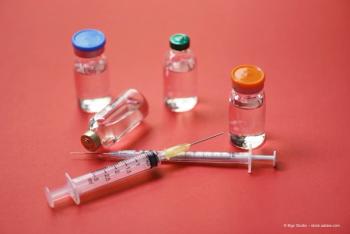
Sustained-release corticosteroid implant improves, slows progression of diabetic retinopathy
Sustained intraocular delivery of fluocinolone acetonide (FAc) using the FAc 0.19 mg intravitreal implant (Iluvien, Alimera Sciences) improves and slows progression of diabetic retinopathy (DR), according to findings of post-hoc analyses of data from the pivotal Fluocinolone Acetonide for Diabetic Macular Edema (FAME) trials.
Reviewed by Peter A. Campochiaro, MD, and Charles C. Wykoff, MD
Sustained intraocular delivery of fluocinolone acetonide (FAc) using the FAc 0.19 mg intravitreal implant (Iluvien, Alimera Sciences) improves and slows progression of diabetic retinopathy (DR), according to findings of post-hoc analyses of data from the pivotal Fluocinolone Acetonide for Diabetic Macular Edema (FAME) trials.
Courtesy of Alimera Sciences
“DR leads to progressive retinal vascular damage and local ischemia, ultimately causing vision loss primarily through diabetic macular edema (DME) and proliferative diabetic retinopathy (PDR),” said Charles C. Wykoff, MD, FAME investigator and a retina specialist in private practice in Houston, TX. “Secondary analyses of the phase III trials leading to FDA-approval of ranibizumab (Lucentis, Genentech) and aflibercept (Eylea, Regeneron) also showed those anti-VEGF treatments can significantly blunt the progression of non-PDR to PDR.”
Related:
Dr. Wykoff pointed out that based on the findings from the phase III FAME trials, the FAc intravitreal implant provides a similar benefit, but it does so with a greatly reduced treatment burden for patients. In the FAME trials, patients received an average of 1.3 injections over a period of 3 years, whereas the anti-VEGF agents were administered monthly to bimonthly in the pivotal trials.”
“In eyes with DR, there is an increase in leukocyte adhesion to retinal vascular endothelial cells that leads to endothelial cell damage, leukocytic plugging, and vessel closure, all of which contributes to progression of DR,” said Peter A. Campochiaro, MD, FAME investigator and professor, Johns Hopkins Wilmer Eye Institute, Baltimore, MD. “Reduction of leukocyte recruitment in diabetic eyes is the likely mechanism by which the FAc intravitreal implant slows DR progression, and sustained delivery of low levels of steroid in the eye are ideal for this indication.”
More:
“The long-acting, slow-release, steady-state effects of the FAc intravitreal implant will have a substantial role to play as the focus in our field continues to shift from solely treating DME and PDR to managing the underlying pathophysiology of DR itself,” Dr. Wykoff added.
FAME findings
The FAME program was comprised of 2 identically designed, randomized, double-masked, 3-year trials that enrolled patients who had persistent DME after at least 1 macular laser photocoagulation treatment.
Across the 2 trials, a total of 376 patients were implanted with the 0.19 mg FAc implant that releases 0.2 mcg/day of the corticosteroid, and 185 patients were assigned to the control group, receiving sham injection. Retreatment was allowed beginning at month 12 if patients experienced a ≥ 5-letter loss in best corrected visual acuity (BCVA) or foveal thickness increase ≥ 50 µm from the lowest measure in the previous 12 months.
Related:
At enrollment, 60% of patients across the FAc 0.19 mg and sham groups had NPDR, which was graded as moderately severe to severe (levels 47-53).
Assessments of the effect of the FAc intravitreal implant on DR status included analyses of time to first PDR event and of changes in diabetic retinopathy severity scale (DRSS) step according to baseline DRSS level and baseline retinal perfusion status. PDR progression was defined as a change from NPDR to PDR based on review of fundus photographs by masked personnel at the study’s reading center, need for panretinal photocoagulation, or need for pars plana vitrectomy for PDR.
Prolonged time to PDR event
The analyses showed that the mean time to first PDR event was significantly later in the FAc implant group compared to the controls (P < 0.001). Subgroup analyses considering eyes with different DRSS levels at baseline also showed significant prolongation in the time to first PDR event in FAc-treated eyes compared with the controls in eyes with baseline DRSS levels of 47-53 (moderately severe-to-severe NPDR) and 60-75 (mild PDR to high-risk PDR).
More:
In addition, the FAc implant significantly prolonged the time to first PDR event in eyes with and without retinal nonperfusion although the greatest benefit was achieved in the subgroups most at-risk for progression to PDR (i.e., eyes with retinal nonperfusion and those with moderately severe-to-severe NPDR).
Using data from the entire population, numeric differences favoring FAc over sham were also found in analyses of the proportion of patients achieving a ≥ 2-step or ≥ 3-step improvement in DRSS score, although the differences between treatment groups did not achieve statistical significance.
Recent:
Peter A. Campochiaro, MD
Charles C. Wykoff, MD
Dr. Campochiaro is a consultant to Alimera Sciences and other companies that market or are developing products for treatment of diabetic eye disease. Dr. Wykoff receives financial support from Alimera Sciences and other companies that market or are developing products for treatment of diabetic eye disease.
Newsletter
Keep your retina practice on the forefront—subscribe for expert analysis and emerging trends in retinal disease management.










































